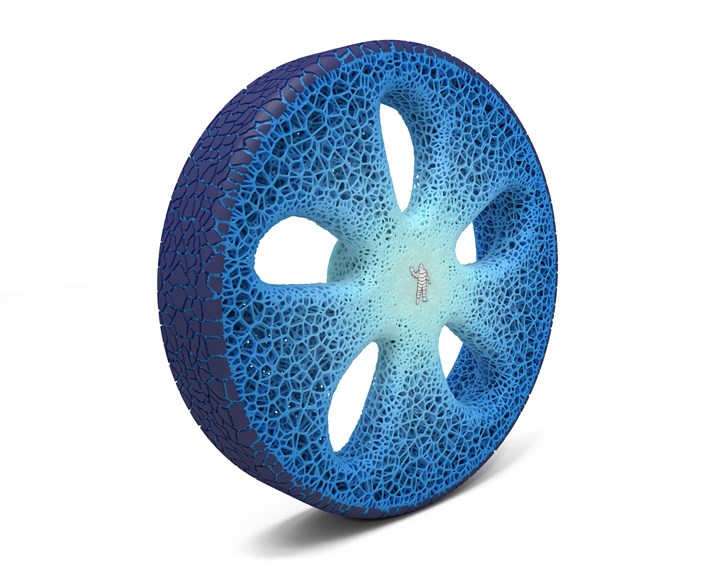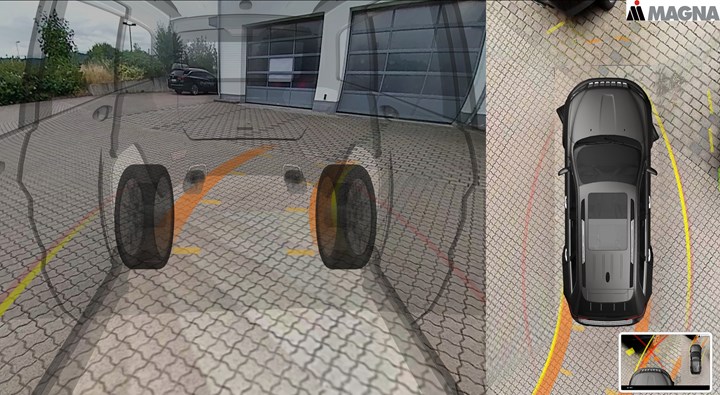On Charging, Sustainable Tires, the Lincoln Nautilus and more
Charging at home, driving on plastic, cameras for exterior, Fisker and Foxconn, and the Lincoln Nautilus reviewed
Welcome to the second edition of Gardner on Automotive. We’d like to ask you to do us a favor: forward this newsletter to a co-worker and ask them to subscribe. The more the merrier. Thanks, Gary.
This week On Automotive:
- There’s No Place Like Home (for Charging)
- Michelin Says It Will be 100% Sustainable by 2050
- Light It Up: Advanced headlamp design facilitated by polymers
- Fisker + Foxconn= Something Different (?)
- Magna Bringing Surround View to the Masses
- 2021 Lincoln Black Label AWD Nautilus: Hush
///
There’s No Place Like Home (for Charging)

More convenient than a gas station. (Image: Electrify America)
Electrify indoors and out. Electrify America, the company that Volkswagen Group established as part of its legal restitution for Dieselgate, an initiative that includes the investment of $2-billion over 10 years in zero emission vehicle (ZEV) infrastructure, education and access, is setting up charging stations across the U.S.
Where? 45 states. 29 metropolitan areas. Some 800 charging stations—including approximately 3,500 DC fast chargers—by December 2021.
But let’s face it: An estimated 82% of homes in the U.S. have a two-car garage, so there are a whole lot of infrastructure opportunities there.
So there’s Electrify Home.
How Come? “Today’s EV drivers are looking for charging solutions that fit seamlessly into their lifestyles, and we’re confident that the HomeStation will deliver that desired level of simplicity for their home charging needs,” said Nina Huesgen, senior manager, Home and eCommerce at Electrify America.
Two Other Reasons. (1) If you’ve ever plugged in an EV in a regular 120-V wall socket you’ve realized the “like paint drying” phenomenon. So the base 40-amp system on offer can power up the vehicle at up to 6.8 times faster. (2) Volkswagen brand has the ID.4 rolling out, so more places to plug in are better. (Although it works with other OEM models, as that Hyundai Kona EV in the picture indicates.)
Fun Fact: The HomeStation was styled by Italdesign, the firm founded by Giorgetto Giugiaro (now owned by Volkswagen Group).
///
Michelin Says It Will be 100% Sustainable by 2050

No, not something from The Little Mermaid, but an alternative design for a tire. (Image: Michelin)
As of 2020, 30% of the components that are used to produce a Michelin Group tire are made from “natural, recycled or otherwise sustainable raw materials.”
Which means 70% aren’t.
Back in 2017 the company developed the VISION concept tire, which is airless and produced with 3D printing. The ideas that went into creating it are still being thought about by the company’s engineers, researchers and chemists.
Lots of Ingredients. A Michelin tire consists of lots of materials. Like more than 200 ingredients. While the main ingredient in a one of its tires is natural rubber, there are also synthetic rubber, metal, fibers, carbon black, silica, and plasticizers.
Four Approaches. (1) Michelin is working with two companies, Axens and IFP Energies Nouvelles, on the development of bio-sourced butadiene, a material used to produce synthetic rubber. Biomass from wood, rice husks, leaves, corn stalks and other plant waste can be used.
(2) It is partnering with Pyrowave on producing recycled styrene, a monomer that can be in the production of synthetic rubber. The material is obtained from things like packaging waste.
(3) A French startup, Carbios, will be located at a Michelin site as of this Fall. It uses enzymes to deconstruct PET plastic waste into monomers, including polyester yarn that can be used in tire manufacturing.
(4) Michelin is part of the European BlackCycle consortium that is working on methods to produce new tires from old.
///
Light It Up

Advanced headlamp design facilitated by polymers. (Image: SABIC)
One of the benefits of using light-emitting diodes (LEDs) for lighting is the ability to create considerably more complex automotive lighting than incandescent bulbs allowed.
And the more-complex designs have necessitated the use of materials that allow the creation of thin walls and sharp draft angles (which can make mold release somewhat tricky).
A material that is permitting the development of advanced bezels is LEXAN polycarbonate (PC) resin. A benefit of LEXAN HF4010SR resin for the production of bezels is that because of its high flow characteristics it can be produced using existing equipment as lower clamping forces and injection pressures are required.
Real Life. The SABIC resin was used by Arteb SA, a Brazilian lighting manufacturer.
Jarbas Enzenberg, Engineering and Quality director, Arteb: “Using standard equipment to mold a bezel with a significantly thinner profile and more-complex design helped Arteb avoid capital costs while delivering exactly what the OEM required.”
Which is what it is all about for a supplier.
///
Fisker + Foxconn= Something Different (?)
Foxconn Technology Group is a leading contract manufacturer of things like iPhones and other electronic devices that are (1) consumer-focused and (2) portable.
At Least the (1) Applies. Fisker Inc, the automotive company that is taking an asset-light approach (i.e., Magna will be making the Fisker Ocean SUV, which is scheduled to launch in Q4 2022), has announced it has established a memorandum of understanding (MOU) with Foxconn. For an electric car.
Somewhat Portable—Perhaps. The two are working on “Project PEAR”: Personal Electric Automotive Revolution.
Henrik Fisker, chairman and CEO of the company that carries his name, said, “We will create a vehicle that crosses social borders, while offering a combination of advanced technology, desirable design, innovation and value for money, whilst delivering on our commitment to create the world’s most sustainable vehicle.”
As the Fisker Ocean is a conventional electric SUV, presumably the fruits of PEAR are going to be something else entirely.
Still Light. And Foxconn is not only collaborating on the development of the vehicle, it will manufacturer it for Fisker. Start of production is anticipated for Q4 2023. The production volume is 250,000 vehicles per year.
///
Magna Bringing Surround View to the Masses

Your vehicle won’t really be invisible. But you’ll see what’s around you in places otherwise invisible. (Image: Magna)
Nowadays, when you put a lux vehicle into “R,” odds are good that on that display screen in the center of the IP there’s a view looking down onto the top of the vehicle such that you can see what’s in the immediate surroundings.
Magna says it has developed next-generation cameras and domain controllers that will allow this sort of capability in less-expensive vehicles.
How It Works. There are four cameras. The images they obtain in the 360 degrees around the vehicle are sent to the domain controller. It creates the image.
This data can also be used to benefit things like automatic emergency braking.
Said Simply. "By providing a high-performance surround view platform that is cost-effective, we’re helping our customers bring added safety and convenience to more drivers. This broader on-the-road experience serves as an excellent enabler for future levels of autonomous driving that will require advanced 360-degree camera performance and full system integration.”--Uwe Geissinger, Magna Electronics President.
///
2021 Lincoln Black Label AWD Nautilus: Hush

This is not the obligatory vehicle exterior image but one of the interior of the Lincoln Nautilus—because it is very, very nice. (Image: Lincoln)
There is something the people at Lincoln understand about luxury that doesn’t seem to be (a) recognized or (b) valued by other companies in the category in which it competes.
Horsepower is Nice. Comfortable Seats Are Better. For some people, luxury is not synonymous with performance. Rather, it is about things like comfort, quality and refinement.
Boxes Checked. The version of the 2021 Nautilus has a twin-turbocharged 2.7-liter V6 engine that produces 335 hp and 380 lb-ft of torque. It is mated to an eight-speed SelectShift transmission (the paddles for which are probably going to be among the least used features of the vehicle). (The standard powertrain is a 2.0-liter turbocharged, 250 hp four and an eight-speed.)
OK. That’s good.
The 22-way adjustable seat that cosseted me when I was behind the wheel is better.
Thought Experiment. You are going to Costco to buy a bunch of stuff. It is a 15-minute drive each way. Do you (a) want to get there three minutes faster or (b) have a quiet, comfortable ride?
The person who appreciates luxury will opt for (b) every time.
Oh. And there’s 37.2-cubic feet of cargo capacity behind the second row, so you’ve got a good amount of space to accommodate that stuff.
Chalet Getaway. The interior execution is something that was undoubtedly orchestrated by someone who attended the Milan Design Week on more than one occasion. There are “Cashmere Leather Specialty Leather Seats” and “Cashmere Venetian Leather-Trimmed with Lincoln Star Perforation Headliner” and “Cashmere Floor Carpet/Mats – Espresso Velour with Metal Cuff Accent.”
I’ve always associated cashmere with sweaters. But call it what you will, it is damned nice.
Upscale Assistance. The Black Label trim level means that there is Lincoln Co-Pilot360 Plus, a driver-assistance package that includes adaptive cruise control that not only adjusts speed as required, but keeps the vehicle centered in the lane (you need to keep your hands on the wheel, but the system does all the little sawing back and forth centering typically requires). Speaking of steering, there is “Evasive Steering Assist,” which gives you a supplement when you need it. There’s Active Park Assist Plus, and Reverse Brake Assist.
Tech, Too. And yes, there is a big screen inside: a 13.2-inch horizontally oriented screen, the biggest one in the Lincoln lineup. (Yes, even bigger than the one in the Navigator.) The Nautilus is the first Lincoln with SYNC 4, (which brings wireless CarPlay and Android Auto, as well as a digital owner’s manual and more). There’s Phone As A Key (once you’ve paired your phone with your Nautilus, you don’t need the keyfob—but it’s a nice keyfob).
RELATED CONTENT
-
Plastics: The Tortoise and the Hare
Plastic may not be in the news as much as some automotive materials these days, but its gram-by-gram assimilation could accelerate dramatically.
-
On Automotive: An All Electric Edition
A look at electric vehicle-related developments, from new products to recycling old batteries.
-
When Automated Production Turning is the Low-Cost Option
For the right parts, or families of parts, an automated CNC turning cell is simply the least expensive way to produce high-quality parts. Here’s why.


.jpg;width=70;height=70;mode=crop)






